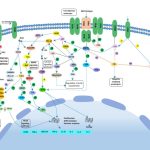The cell structure comprises individual components with specific functions essential to carry out life’s processes. These components include- cell wall, cell membrane, cytoplasm, nucleus, and cell organelles. Read on to explore more insights on cell structure and function.
Cell Membrane
- The cell membrane supports and protects the cell. It controls the movement of substances in and out of the cells. It separates the cell from the external environment. The cell membrane is present in all the cells.
- The cell membrane is the outer covering of a cell within which all other organelles, such as the cytoplasm and nucleus, are enclosed. It is also referred to as the plasma membrane.
- By structure, it is a porous membrane (with pores) which permit the movement of selective substances in and out of the cell. Besides this, the cell membrane also protects the cellular component from damage and leakage.
- It forms the wall-like structure between two cells as well as between the cell and its surroundings.
- Plants are immobile, so their cell structures are well-adapted to protect from them from external factors. The cell wall helps to reinforce this function.
Cell Wall
- The cell wall is the most prominent part of the plant’s cell structure. It is made up of cellulose, hemicellulose and pectin.
- The cell wall is present exclusively in plant cells. It protects the plasma membrane and other cellular components. The cell wall is also the outermost layer of plant cells.
- It is a rigid and stiff structure surrounding the cell membrane.
- It provides shape and support to the cells and protects them from mechanical shocks and injuries.
Cytoplasm
- The cytoplasm is a thick, clear, jelly-like substance present inside the cell membrane.
- Most of the chemical reactions within a cell take place in this cytoplasm.
- The cell organelles such as endoplasmic reticulum, vacuoles, mitochondria, ribosomes, are suspended in this cytoplasm.
Nucleus
- The nucleus contains the hereditary material of the cell, the DNA.
- It sends signals to the cells to grow, mature, divide and die.
- The nucleus is surrounded by the nuclear envelope that separates the DNA from the rest of the cell.
- The nucleus protects the DNA and is an integral component of a plant’s cell structure.
Cell Organelles
Cells are composed of various cell organelles that perform certain specific functions to carry out life’s processes. The different cell organelles, along with its principal functions, are as follows:
| Cell Organelle and its Functions |
| Nucleolus |
| The nucleolus is the site of ribosome synthesis. Also, it is involved in controlling cellular activities and cellular reproduction |
| Nuclear membrane |
| The nuclear membrane protects the nucleus by forming a boundary between the nucleus and other cell organelles. |
| Chromosomes |
| Chromosomes play a crucial role in determining the sex of an individual. Each human cells contain 23 pairs of chromosomes |
| Endoplasmic reticulum |
| The endoplasmic reticulum is involved in the transportation of substances throughout the cell. It plays a primary role in the metabolism of carbohydrates, synthesis of lipids, steroids, and proteins. |
| Golgi Bodies |
| Golgi bodies are called the cell’s post office as it is involved in the transportation of materials within the cell |
| Ribosome |
| Ribosomes are the protein synthesisers of the cell |
| Mitochondria |
| The mitochondrion is called “the powerhouse of the cell.” It is called so because it produces ATP – the cell’s energy currency |
| Lysosomes |
| Lysosomes protect the cell by engulfing the foreign bodies entering the cell and helps in cell renewal. Therefore, it is known as the cell’s suicide bags |
| Chloroplast |
| Chloroplasts are the primary organelles for photosynthesis. It contains the pigment chlorophyll |
| Vacuoles |
| Vacuoles stores food, water, and other waste materials in the cell |
Cell Theory
Cell Theory was proposed by the German scientists, Theodor Schwann, Matthias Schleiden, and Rudolf Virchow. The cell theory states that:
- All living species on Earth are composed of cells.
- A cell is the basic unit of life.
- All cells arise from pre-existing cells.
A modern version of the cell theory was eventually formulated, and it contains the following postulates:
- Energy flows within the cells.
- Genetic information is passed on from one cell to the other.
- The chemical composition of all the cells is the same.


